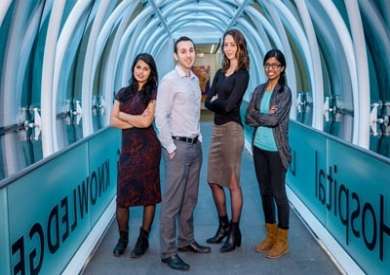Tracking the Zika virus

Imagine a fourth-year work placement with global impact. At BlueDot, students and alumni from Ryerson's Department of Geography are helping to spearhead the next generation of infectious disease research.
Based at St. Michael's Hospital's Li Ka Shing Knowledge Institute, BlueDot uses big data to predict the outbreak and spread of diseases. Launched in 2013 by Dr. Kamran Khan after a long gestation period, the company gathers experts in geographic information systems (GIS), spatial analysis, data visualization and computer science to create mathematical predictive models. BlueDot has already made headlines for predicting the spread of the Zika virus from Brazil.
"We're mapping the disease to see different levels in prevalence," said Carmen Huber, a fourth-year Geography student working part-time at the company. "A lot of the time we're looking at travel data in and out of affected areas, or looking at environmental factors. With Zika, we look at the areas in which the mosquito that can carry Zika is able to survive. … The maps we create make it very easy for decision-makers to actually visualize the data."
How does geography play into medical science? "Geography is so multidisciplinary," said Anne Christian, a full-time Ryerson Master of Spatial Analysis (MSA) student on a practicum placement at the company. "In terms of health, geography can be used to map the spread of the infectious disease, and map areas with the most risk. If you want to find areas in Toronto where people are most susceptible to catching a specific virus, you might want to check the population density, or where are people travelling where they might come into contact with many different people, or airports where people are coming into Toronto."
The company keeps its employees on the cutting edge of big data, said Adrian Nicolucci, an MSA graduate and current data engineer for the company. "We're able to know so much about the world around us. So many new sensors capturing all these different things we could only have imagined existed 10 years ago. It's definitely an exciting field to be in."
Carmen Huber and Sonya Karamchandani are fourth-year BA in Geographic Analysis students working at BlueDot to gain the required work experience before graduation. For them, BlueDot's global reach provides a unique learning opportunity. "Every single day you learn," said Karamchandani. "You learn about the diverse people that work in this kind of environment: you have clinicians working side-by-side with epidemiologists and people who have degrees in data science and engineering."
"It's been really eye opening to see how the skills I'm learning at school can actually have an impact on really relevant issues," said Huber. "It supports decision makers, and relating to Zika, those decisions can have an impact on thousands of people's lives. It's really great to know that I'm a part of that."
"Our work has impact at a global scale," added Nicolucci. "For me, it's really rewarding to know we have the potential to impact global policy."
More information: To learn more about BlueDot, go to bluedot.global/



















